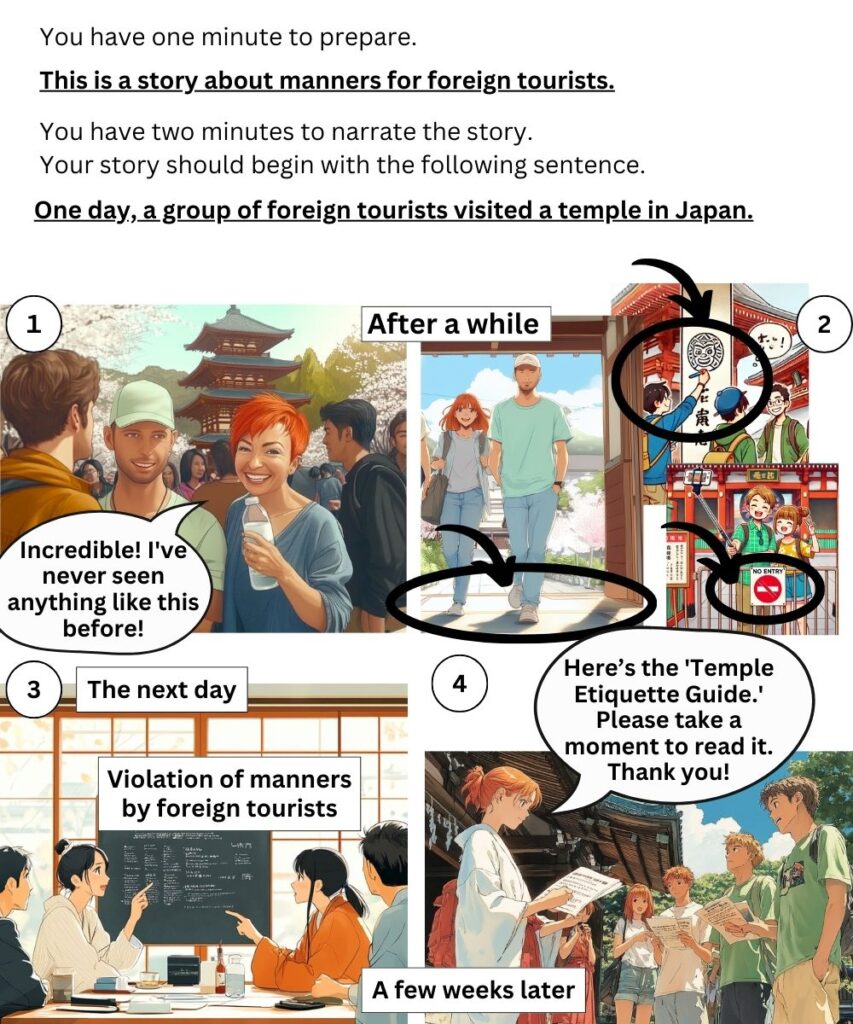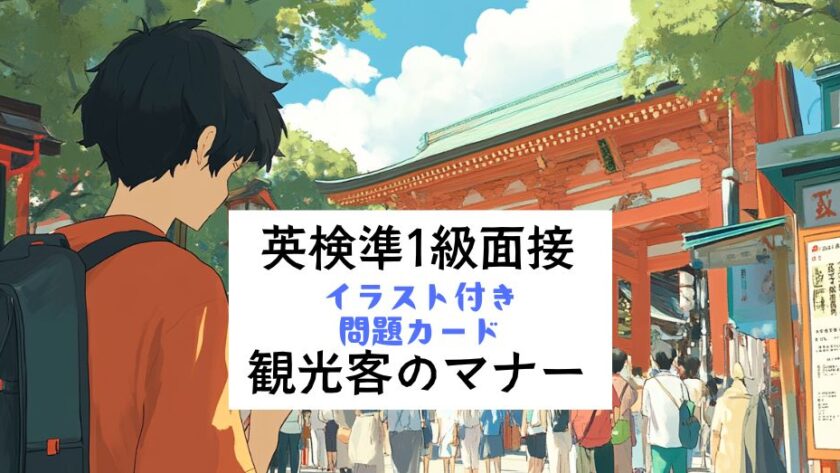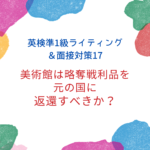メタディスクリプション:
実際の出題形式(問題カード)で英検準1級の面接練習を独学できるページです。
2024年度リニューアル対応!
所要時間:概ね8分
質問概要
ナレーション内容を考える(1分間)
イラストの内容を説明するナレーションを考える
ナレーション(2分間):ナレーションを始める
※2分以上続く場合は、途中でも中止させられるので注意
Q&A(No. 1):イラスト関連の質問
イラストに関連した質問。「問題カード」を見ながら解答できます。
※登場人物が考えている事などを聞かれます。
Q&A(No.2, No. 3)
問題カードに関連した、受験者の意見を問う質問
Q&A(No. 4)
問題カードのトピックに少し関係のある質問。受験者の意見を問う質問
※この<No. 4>質問文に「導入文」が追加されました。
問題カード

ナレーションと質問
ナレーション指示
<指示>Look at the pictures carefully and read the directions silently for one minute.(1分間)
<指示>Now, please begin your narration.(2分間)
Question No.1
Please look at the second picture. If you were one of the locals who noticed the tourists’ behavior, what would you be thinking?
Question No.2
Do you think pamphlets are an effective way to educate tourists about local customs?
Question No.3
What other methods could be used to help tourists understand and respect local customs?
Question No.4
In recent years, Japan has seen a significant increase in the number of foreign tourists visiting cultural heritage sites like temples and shrines. Do you think that increasing tourism can have a negative impact on cultural heritage sites?
質問音源チャレンジ
本番のように、英語の質問を聞いて答える練習をしてみましょう。
ナレーション準備
ナレーション開始
Question 1 mp3
Question 2 mp3
Question 3 mp3
Question 4 mp3
解答例
ナレーション例
ナレーション全文聞き流し:
<1> One day, a group of foreign tourists visited a temple in Japan. They were excited and fascinated by the temple’s traditional architecture. One of them exclaimed that he had never seen anything like it before.
ある日、外国人観光客の一団が日本の寺院を訪れた。彼らはその伝統的な建築に興奮し、魅了された。ある観光客は、こんなものは今まで見たことがないと感嘆した。
「exclaim = 感嘆した」系の表現をいくつか押さえておこう
1. shout(叫ぶ): 驚きや怒り、強い感情を表現するために使われる。
2. cry out(叫び声を上げる): 驚きや痛み、恐怖などの感情に反応して発せられる声。
3. blurt out(うっかり言う): 無意識に、または感情に任せて発言することを意味する。
4. declare(宣言する): 公に、または強い意志を持って何かを言い表すこと。
5. proclaim(宣言する): 公他の人に広く知られるように言うことを意味する。
<2> After a while, they began exploring the temple, but unknowingly broke several rules. They walked with their shoes on inside the temple and entered areas that were restricted to visitors. The temple staff noticed this behavior and became concerned that the tourists were unaware of the temple’s customs.
しばらくして、彼らは寺院を探索し始めたが、知らずにいくつかのルールを破ってしまった。彼らは寺院内を靴を履いたまま歩き、立入禁止の区域に入ったのである。お寺のスタッフはこの行動に気づき、観光客が寺院の習慣を知らないことに懸念を抱いた。
「 areas that were restricted to visitors = 立ち入り禁止の区域」
1. restricted areas(制限区域)
2. no-entry zones(立ち入り禁止ゾーン)
3. off-limits areas(立ち入り禁止エリア)
4. prohibited areas(禁止区域)
5. forbidden areas(立ち入り禁止エリア)
<3> The next day, the temple staff gathered in the office to discuss the tourists’ behavior. They were worried about the increasing violations of temple etiquette by foreign visitors and decided to take action to prevent such incidents from happening again.
翌日、お寺のスタッフたちは観光客の行動について話し合うためにお寺の事務所に集まった。彼らは、外国人観光客による寺院のマナー違反が増えていることに懸念を抱いていた。そこで、再発を防ぐために対策を講じることにした。
「take action = 対策を講じる」系の表現をいくつか押さえておこう。
1. take steps(措置を講じる)
2.take measures(対策を取る)
3. make a move(行動を起こす)
4. initiate action(行動を開始する)
5. respond proactively(積極的に対応する)
<4> A few weeks later, the “Temple Etiquette Guide” that the staff had planned was delivered. When foreign tourists visited the temple, the staff handed them the pamphlet and kindly asked them to read it before entering. The tourists read the guide, followed the rules, and showed respect for the temple’s customs, making their visit much more enjoyable for everyone involved.
数週間後、スタッフで企画した「寺院マナーガイド」が納品された。外国人観光客が寺院を訪れたとき、スタッフはそのパンフレットを手渡し、入場前に読むように親切に依頼した。観光客たちはそのガイドを読み、ルールを守って寺院の習慣を尊重し、誰にとってもより楽しい訪問となった。
Question 1 解答例
質問:2枚目の写真を見てください。あなたが観光客の行動に気づいた地元住民の一人だったら、どう思いますか?
I would be thinking about how important it is to respect the customs and traditions of sacred places like the temple. I might also feel concerned about how such incidents could negatively affect the relationship between the local community and foreign visitors. Additionally, I would probably think about ways to help educate tourists on proper temple etiquette to avoid future misunderstandings.
寺院のような神聖な場所の習慣や伝統を尊重することの重要性について考えるでしょう。また、このような出来事が地元のコミュニティと外国人観光客の関係に悪影響を及ぼさないか心配するかもしれません。さらに、今後の誤解を避けるために、観光客に適切な寺院での礼儀作法を教える方法についても考えるでしょう。
Question 2 解答例
パンフレットは観光客に地元の習慣について教育する効果的な方法だと思いますか?
Yes. Pamphlets are an effective way to educate tourists because they provide clear and concise information about local customs and rules. They can be distributed easily and read quickly, helping to prevent misunderstandings before they occur. Additionally, they can be offered in multiple languages, ensuring that a wide range of visitors can understand the content.
はい。パンフレットは、地元の習慣やルールについて観光客に教育する効果的な方法だと思います。パンフレットは簡潔で明確な情報を提供し、配布も容易で、短時間で読むことができるため、誤解を未然に防ぐのに役立ちます。また、複数の言語で提供することができ、多くの観光客が内容を理解できるようにすることができます。
Question 3 解答例
観光客が地元の習慣を理解し、尊重するために他にどのような方法が考えられるでしょうか?
In addition to pamphlets, visual aids like signs and posters with clear symbols and images can help tourists understand local customs. Guided tours led by knowledgeable locals are also effective, as they can provide real-time explanations and answer any questions tourists might have. Interactive apps that provide cultural information and quizzes can also be an engaging way for tourists to learn about and respect the local customs.
パンフレットに加えて、明確なシンボルやイメージを用いた看板やポスターも、観光客が地元の習慣を理解するのに役立ちます。また、知識豊富な地元住民が案内するガイドツアーも効果的です。彼らはリアルタイムで説明を行い、観光客の質問にも答えることができます。文化情報やクイズを提供するインタラクティブなアプリも、観光客が地元の習慣を学び、尊重するための興味深い方法です。
Question 4 解答例
近年、日本では寺社などの文化遺産を訪れる外国人観光客が大幅に増加しています。観光客の増加は文化遺産に悪影響を与える可能性があると思いますか?
Yes. Increasing tourism can have a negative impact on cultural heritage sites because the influx of visitors can lead to wear and tear on the physical structures and contribute to the degradation of the site’s cultural significance. Overcrowding can also disrupt the peaceful atmosphere that many of these sites are meant to preserve. It is essential to manage tourism carefully to ensure that these important sites are protected for future generations.
はい。観光客の増加は、訪問者の流入が物理的構造の摩耗につながり、サイトの文化的重要性の低下に寄与する可能性があるため、文化遺産に悪影響を与える可能性があります。また、過密状態は、多くの文化遺産が保持しようとしている静かな雰囲気を乱すことがあります。これらの重要な場所を将来の世代のために保護するためには、観光を慎重に管理することが必要です。
No. While an increase in tourism can put pressure on cultural heritage sites, it also provides opportunities for increased funding and resources dedicated to the preservation and maintenance of these sites. By implementing proper management strategies, such as limiting the number of visitors and promoting responsible tourism practices, the negative impacts can be minimized, allowing cultural heritage sites to be enjoyed by future generations without significant harm.
いいえ。観光の増加は文化遺産に負担をかける可能性がありますが、それと同時に、これらの場所の保存と維持に必要な資金やリソースを増やす機会も提供します。適切な管理戦略を導入し、訪問者数を制限したり、責任ある観光の実践を促進することで、悪影響を最小限に抑え、文化遺産を将来の世代が大きな損害を受けることなく楽しむことができるでしょう。
面接練習はask本校にお尋ねください:無料体験レッスン予約
こちらの投稿もおススメです:英検準1級面接問題カード|在宅勤務トピック質問と回答例
外国人観光客に教えたい日本文化ベスト10
1. Removing Shoes
- Removing shoes before entering homes or certain indoor areas.
- 家や特定の室内に入る前に靴を脱ぐこと。
2. Bowing
- Understanding the proper way to bow and when to use it.
- 正しいお辞儀の仕方とそのタイミングを理解すること。
3. Quietness in Public
- Staying quiet in public spaces like trains and buses.
- 電車やバスなどの公共の場で静かにすること。
4. Using Chopsticks
- Properly using chopsticks and knowing the cultural taboos associated with them.
- 正しい箸の使い方と、その文化的タブー(刺し箸、立て箸、渡し箸など)
5. Trash Separation
- Sorting trash into various categories for recycling.
- ゴミをリサイクルのためにさまざまなカテゴリーに分けること。
6. Onsen Etiquette
- Knowing the rules for bathing in an onsen, like washing before entering.
- 温泉に入る際のルール(入る前に体を洗うなど)を知ること。
7. Gift Giving
- Understanding the customs of giving and receiving gifts.
- 贈り物をする際の習慣を理解すること。
8. Politeness Phrases
- Using polite language and understanding phrases like “sumimasen.”
- 丁寧な言葉遣いをし、「すみません」のようなフレーズを理解すること。
9. Queueing
- Waiting patiently in line and not cutting in.
- 列に静かに並び、割り込みをしないこと。
10. Tipping
- Realizing that tipping is not customary in Japan.
- 日本ではチップが習慣ではないことを理解すること。




